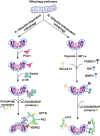The Nucleus/Mitochondria-Shuttling LncRNAs Function as New Epigenetic Regulators of Mitophagy in Cancer
- PMID: 34568319
- PMCID: PMC8455849
- DOI: 10.3389/fcell.2021.699621
The Nucleus/Mitochondria-Shuttling LncRNAs Function as New Epigenetic Regulators of Mitophagy in Cancer
Abstract
Mitophagy is a specialized autophagic pathway responsible for the selective removal of damaged or dysfunctional mitochondria by targeting them to the autophagosome in order to maintain mitochondria quality. The role of mitophagy in tumorigenesis has been conflicting, with the process both supporting tumor cell survival and promoting cell death. Cancer cells may utilize the mitophagy pathway to augment their metabolic requirements and resistance to cell death, thereby leading to increased cell proliferation and invasiveness. This review highlights major regulatory pathways of mitophagy involved in cancer. In particular, we summarize recent progress regarding how nuclear-encoded long non-coding RNAs (lncRNAs) function as novel epigenetic players in the mitochondria of cancer cells, affecting the malignant behavior of tumors by regulating mitophagy. Finally, we discuss the potential application of regulating mitophagy as a new target for cancer therapy.
Keywords: cancer metabolism; cancer stem cells; cancer therapy; long non-coding RNA; mitochondria; mitophagy.
Copyright © 2021 Li, Li, Hoffman, Cui and Hu.
Conflict of interest statement
The authors declare that the research was conducted in the absence of any commercial or financial relationships that could be construed as a potential conflict of interest.
Figures




Similar articles
-
Mitophagy in Cancer: A Tale of Adaptation.Cells. 2019 May 22;8(5):493. doi: 10.3390/cells8050493. Cells. 2019. PMID: 31121959 Free PMC article. Review.
-
Mitophagy: Link to cancer development and therapy.Biochem Biophys Res Commun. 2017 Jan 15;482(3):432-439. doi: 10.1016/j.bbrc.2016.10.088. Epub 2017 Feb 3. Biochem Biophys Res Commun. 2017. PMID: 28212727 Review.
-
Mitochondria autophagy: a potential target for cancer therapy.J Drug Target. 2021 Jul;29(6):576-591. doi: 10.1080/1061186X.2020.1867992. Epub 2021 Feb 8. J Drug Target. 2021. PMID: 33554661 Review.
-
The emerging, multifaceted role of mitophagy in cancer and cancer therapeutics.Semin Cancer Biol. 2020 Nov;66:45-58. doi: 10.1016/j.semcancer.2019.07.015. Epub 2019 Jul 24. Semin Cancer Biol. 2020. PMID: 31351198 Review.
-
Mitochondrial rewiring through mitophagy and mitochondrial biogenesis in cancer stem cells: A potential target for anti-CSC cancer therapy.Cancer Lett. 2021 Feb 1;498:217-228. doi: 10.1016/j.canlet.2020.10.036. Epub 2020 Nov 10. Cancer Lett. 2021. PMID: 33186655 Review.
Cited by
-
Emerging Role of Autophagy in Governing Cellular Dormancy, Metabolic Functions, and Therapeutic Responses of Cancer Stem Cells.Cells. 2024 Mar 4;13(5):447. doi: 10.3390/cells13050447. Cells. 2024. PMID: 38474411 Free PMC article. Review.
-
An Update of Long-Noncoding RNAs in Acute Kidney Injury.Front Physiol. 2022 Mar 8;13:849403. doi: 10.3389/fphys.2022.849403. eCollection 2022. Front Physiol. 2022. PMID: 35350698 Free PMC article. Review.
-
Mitophagy-Related Gene Signature for Prediction Prognosis, Immune Scenery, Mutation, and Chemotherapy Response in Pancreatic Cancer.Front Cell Dev Biol. 2022 Feb 7;9:802528. doi: 10.3389/fcell.2021.802528. eCollection 2021. Front Cell Dev Biol. 2022. PMID: 35198564 Free PMC article.
-
Predictive and Prognostic Value of Non-Coding RNA in Breast Cancer.Cancers (Basel). 2022 Jun 15;14(12):2952. doi: 10.3390/cancers14122952. Cancers (Basel). 2022. PMID: 35740618 Free PMC article. Review.
-
Construction and validation of a diagnostic model for rheumatoid arthritis based on mitochondrial autophagy-related genes.Heliyon. 2024 Jan 18;10(3):e24818. doi: 10.1016/j.heliyon.2024.e24818. eCollection 2024 Feb 15. Heliyon. 2024. PMID: 38327427 Free PMC article.
References
Publication types
Grants and funding
LinkOut - more resources
Full Text Sources

